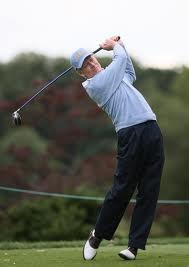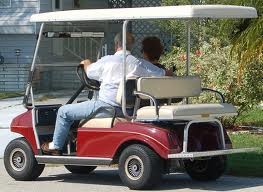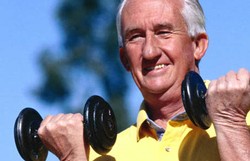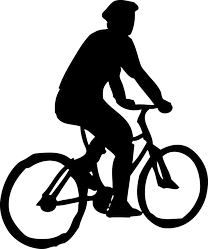Many persons turn to golf as they age because sports such as tennis and running become too strenuous. Those who already golf usually continue playing into old age. Golf is associated with relaxation and gentle, steady exercise. Golf does improve coordination, helps maintain a healthy weight, and increases muscle tone. However, without proper training, golf can lead to debilitating injuries, including back, neck and shoulder pain.

Golfing for Seniors: Preventing Golf Injuries
by CMarie
Even if you are an expert, middle-aged and senior golfers should play it safe to prevent injuries that will keep you from playing this summer. If you have chosen golf as a new ret
Most Prevalent Golf Injuries in Middle Age
The most common golf injuries affect the back, shoulder and elbow. In a small study of 240 golfers ranging in age from 30 - 55 years, 46% had experienced at least one orthopedic injury. In order of incidence, these were the most common injuries:
- lower back injury
- shoulder injury
- dorsal spine (mid back) injury
- neck pain
- wrist and elbow pain
Because back pain was the most prevalent of all injuries, the incidence of back injury was analyzed. The 47 – 60 year old age group was the most prone to back injuries.
These injuries were caused by failure to warm up and improper swing. The Mayo Clinic cites that poor swing mechanics and overuse injuries are especially prevalent among new golfers.
Prevention of Golf Injuries – Proper Swing
To prevent a large percent of golf injuries, the Mayo Clinic provides the following advice about the proper way to swing:
Good posture is essential to a safe golf swing. The feet should be placed shoulder width apart with weight evenly balanced over each foot. Do not hunch over the ball to prevent neck and back pain.
- Swing the club with your whole body. The force of your swing is generated by all of your muscles, from your feet to your legs, by your core and upper body. Do not swing with your wrists, or you will risk injury to your wrist and forearm. Moreover, the resulting swing will be weak.
- Avoid “overswing.” A good swing is even, relaxed and consistent, not fast and hard. Swinging with too much force can result in joint injury.
There is software available on the Internet to evaluate your swing. An even better choice is golf lessons until you have a safe swing that will also improve your game.
Warming Up and Stretching
Failure to warm up and stretch for increased flexibility was identified by the Mayo Clinic as one of the major causes of all golf injuries.
To warm up, walk and swing the golf club a few times, increasing your range of motion each time. Practicing your golf swing for an hour is actually harmful and may cause muscle strain instead of building strength and endurance.
Stretch the shoulders, arms, hamstrings and back daily.
 Prevent Injury and Improve Your Swing |
Importance of Body Strength and Endurance
Done correctly, swinging a golf club is a whole-body exercise. Overall muscle strength and endurance are critical to avoiding injuries on the links. Exercise before taking up golf, and exercise all year long, not just during the golf season.
- For muscle strength, do core exercises, such as abdominal crunches. Weight training and resistance exercises can be used to strengthen the biceps, triceps, back, chest and legs.
- For endurance on the golf course, do aerobic exercises. This will prevent injuries caused by fatigue.
Take Lessons
It is strongly recommended that new golfers take lessons until they achieve good swing mechanics. For older golfers, it’s worth it to have your swing or your overall body mechanics assessed for areas of weakness. This can be done by a trainer or physical therapist. Lessons and assessment of your golf swing should be performed by persons certified in an approved golf-training course or someone who works with the Professional Golf Association.
Play it Safe and Improve Your Game
Golf is a great choice for fitness and fun in middle age. However, it is best played after learning good swing mechanics and building your strength and endurance. It is a whole body exercise and when played without preparation, areas of weakness may result in injury.
So playing it safe by learning body mechanics for swinging and strengthening your core will not only prevent injuries but improve your game this summer.
 Prevent Injuries and Enjoy Golf |
Disclaimer: The information contained in this article is for educational purposes only and should not be used for diagnosis or to guide treatment without the opinion of a health professional. Any reader who is concerned about his or her health should contact a doctor for advice.
You might also like
Is Exercising The ‘Fountain of Youth’?Exercising for the elderly is important and can have great health benefits
Cycling For Seniors - Cycling In Retirement for Fitness, Fun a...Ever since Bradley Wiggins and Chris Hoy brought glory to British cycling, ...





 Middle Aged? Step Up Your Workout with High Interval Walkingon 05/12/2013
Middle Aged? Step Up Your Workout with High Interval Walkingon 05/12/2013
 Osteoporosis and Ballroom Dancing: A Perfect Matchon 04/25/2013
Osteoporosis and Ballroom Dancing: A Perfect Matchon 04/25/2013



Comments